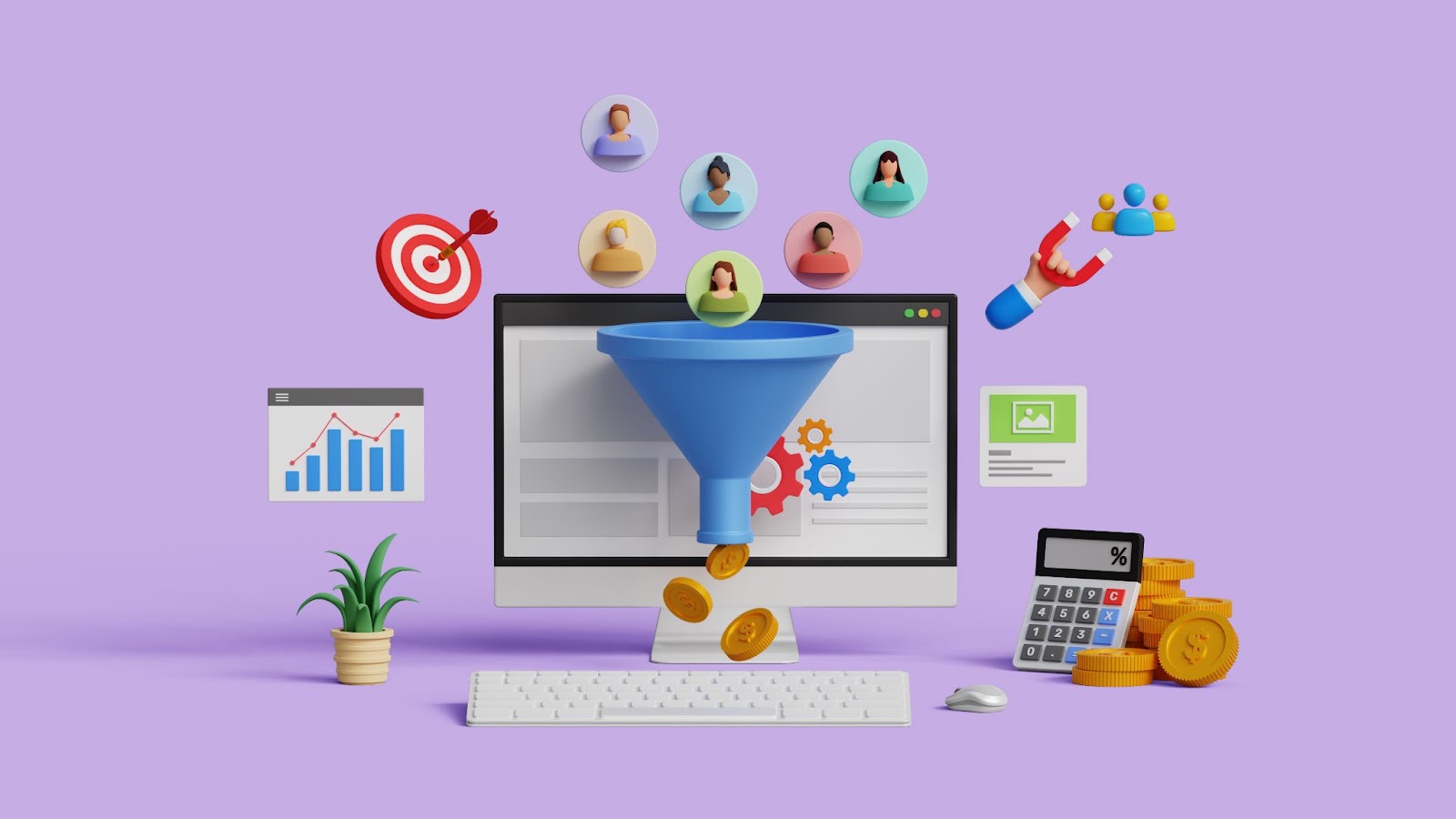The marketing funnel outlines the customer journey from discovering your brand to making a purchase. It helps businesses attract, engage, and retain customers effectively by breaking the process into three stages: awareness, consideration, and conversion.
The funnel aligns with business goals by simplifying decision-making into actionable steps. For example, top-of-funnel efforts drive traffic through educational content, mid-funnel strategies nurture leads with case studies, and bottom-funnel tactics optimize checkout flows for conversions.
This structured approach strengthens customer relationships, improves conversion rates, and drives measurable business growth.
Awareness stage: Capturing attention and sparking interest
The awareness stage introduces your brand to potential customers by grabbing attention, building recognition, and positioning your business as a solution to their needs. By making a strong first impression and reaching a wide audience, you lay the groundwork for the rest of the customer journey.
Key strategies for success
Create engaging content
Publish blogs, videos, infographics, or downloadable resources that educate and showcase your expertise. For example, a skincare brand could share tips on combating winter dryness while highlighting its products.
Leverage social media
Use posts, reels, and influencer collaborations to amplify your message and encourage interactions. Optimize for SEO to ensure your content reaches users searching for related topics.
Run targeted ads
Use visually striking display ads or video campaigns on platforms like Google Ads or YouTube. A fitness app, for instance, could feature workout videos to attract health-conscious users.
Metrics to measure success
Track impressions, reach, website traffic, and social media engagement to evaluate how well your efforts resonate and drive interest.
Excelling in the awareness stage helps you capture attention, build trust, and set the stage for nurturing potential customers through the next phases of the marketing funnel.
Consideration stage: Building trust and showcasing value
In the consideration stage, nurture leads by addressing their challenges and demonstrating how your product or service meets their needs. Build trust with valuable insights and position yourself as the ideal solution to guide them closer to a decision.
Key strategies for success
Targeted email campaigns
Send emails focused on lead interests, like a software company highlighting features with user testimonials.
Retargeting ads
Keep your brand top of mind with ads reminding visitors of products or services they viewed, encouraging them to return.
Webinars and demos
Showcase your expertise with live sessions that provide in-depth solutions to industry-specific challenges.
Case studies
Share real-world success stories to prove your offering’s value, like a project management tool demonstrating increased productivity.
Metrics to measure success
Monitor lead generation, click-through rates, engagement with resources, and time spent on your site to gauge the effectiveness of your efforts.
By providing tailored content and meaningful engagement, you build trust, address concerns, and move leads closer to making a confident decision.
Conversion stage: Turning interest into action
In the conversion stage, transform prospects into customers by streamlining the purchasing process and building confidence. This final step secures sales and sets the foundation for lasting relationships.
Strategies for success
Compelling CTAs
Use clear, actionable phrases like “Buy Now” or “Start Your Free Trial” prominently on landing pages and emails to guide decisions.
Create urgency
Motivate quick action with limited-time offers, like “Only 24 Hours Left!” or “Exclusive Discount Ends Soon!”
Build trust
Showcase testimonials, reviews, and user-generated content to validate your product’s value.
Reduce risk
Offer free trials or money-back guarantees to encourage commitment without hesitation.
Optimize the experience
Design user-friendly, mobile-optimized landing pages with transparent pricing and minimal steps to purchase.
Measure success
Track conversion rates, revenue, and customer acquisition cost (CAC) to ensure your strategies deliver strong returns. High conversions with low CAC signal a well-optimized process.
Creating a seamless and persuasive experience turns interest into action, boosts sales, and fosters loyalty, which in turn promotes continued business growth.
Aligning the funnel with your marketing strategy

Ensure consistent messaging and branding
Maintain cohesive messaging across all stages of the funnel. Use a unified voice, tone, and visual identity to build trust and familiarity. When prospects see consistent branding, they connect more strongly with your business.
Whether you create a social media post, send an email, or design a landing page, align your language with your brand values. For instance, if your brand emphasizes sustainability, highlight eco-friendly practices in all communications.
Tailor content to match the customer’s funnel position
Deliver content that aligns with each stage of the customer journey. Introduce your brand during the awareness stage with blog posts, infographics, or engaging social media campaigns. In the consideration stage, provide detailed resources like case studies, webinars, and comparison guides to help customers evaluate your offerings.
During the conversion stage, focus on clear CTAs, customer testimonials, and seamless purchasing options. By matching content to the customer’s needs, you guide them naturally to the next step.
Use data and insights to refine your strategies
Analyze customer behavior to improve your funnel. Track metrics like engagement rates, time spent on your website, and conversion rates to identify strengths and gaps.
If you notice high traffic during the awareness stage but low engagement in the consideration stage, adjust your middle-funnel content. Strengthen your email sequences, retarget ads, or webinar offerings to keep leads engaged.
Test and adapt your strategies based on insights. If A/B testing shows a particular CTA drives higher conversions, implement that language across campaigns. Segment your audience based on data to craft messaging and offers that resonate with specific groups. A data-driven approach keeps your strategy responsive to customer needs and market trends.
Integrate feedback to enhance alignment
Collect feedback from sales teams, customer service staff, and customers to refine your approach. Identify common questions, challenges, and opportunities to improve. For instance, if customers frequently request detailed product comparisons, create targeted content for the consideration stage.
When you align your funnel with a cohesive marketing strategy, you deliver relevant, consistent, and impactful experiences. This alignment strengthens customer trust, enhances brand loyalty, and improves your campaign results.
Common challenges and how to overcome them
Ineffective audience segmentation
When marketers fail to segment their audience effectively, they deliver generic messaging that doesn’t resonate. Grouping diverse prospects together leads to missed opportunities for personalized communication, reducing engagement and results.
You can solve this by using tools like CRM software or marketing automation platforms to segment your audience based on behavior, demographics, and preferences. Create detailed buyer personas to understand your customers’ motivations.
For instance, separate frequent buyers, new prospects, and cart abandoners into unique segments. Send tailored emails or retargeting ads that re-engage each group with personalized offers.
Gaps in lead nurturing
Inconsistent or poorly timed communication often causes leads to lose interest. Without a clear nurturing strategy, prospects stall in the consideration stage, unsure of the value your business offers.
You can overcome this by building a structured lead nurturing system. Use automated email workflows, targeted ads, and personalized content to engage leads at the right time.
For example, after a lead downloads a whitepaper, send follow-up emails offering related resources or inviting them to a webinar. Regular engagement helps move leads through the funnel until they’re ready to convert.
Conversion barriers
Complicated checkout processes, unclear calls to action, or a lack of trust-building elements often discourage prospects from completing their purchase. These barriers create friction that deters buyers.
Reduce conversion barriers by optimizing your conversion process. Simplify landing pages with clear and compelling CTAs, and streamline your checkout process to minimize distractions. Build trust by including testimonials, trust badges, or satisfaction guarantees.
For example, offering a free trial with no upfront commitment can encourage hesitant buyers to take action.

Revity Marketing Agency is ready to help you navigate the marketing funnel with ease & expertise
At Revity Marketing Agency, we specialize in helping businesses navigate the complexities of audience segmentation, lead nurturing, and conversion optimization. Our tailored solutions ensure consistent messaging, data-driven strategies, and measurable results at every stage of the funnel. Contact Revity to elevate your marketing efforts, overcome challenges, and achieve lasting success. Transform your marketing strategy and drive real growth!







